2023 FORD F150 belt
[x] Cancel search: beltPage 59 of 786

Perform the following steps wheninstalling a child restraint with seatbelts.
1.Position the child restraint in a seatwith a seatbelt.
2.Pull down on the shoulder belt andthen grasp the shoulder belt and lapbelt together.
3.While holding the shoulder and lap beltportions together, route the tonguethrough the child restraint accordingto the child restraint manufacturer'sinstructions. Make sure you did nottwist the belt webbing.
4.Insert the belt tongue into the properbuckle for that seating position untilthe latch engages. Make sure thetongue is latched securely by pullingon it.
5.To put the retractor in the automaticlocking mode, grasp the shoulderportion of the belt and pull downwarduntil you pull all of the seatbelt out.
Note:The automatic locking mode isavailable on the front passenger and rearseats. This mode is also available on thecenter seat of a Regular Cab. This vehicledoes not require the use of a locking clip.
6.Allow the belt to retract to removeslack. The seatbelt clicks as it retractsto indicate it is in the automatic lockingmode.
55
2023 F-150 (TFD) Canada/United States of America, enUSA, Edition date: 202206, DOMChild SafetyE142529 E142530 E142531 E142875
Page 60 of 786

7.Pull the seatbelt out of the retractor tomake sure the retractor is in theautomatic locking mode. You shouldnot be able to pull more belt out. If theretractor is not locked, unbuckle thebelt and repeat Steps 5 and 6.
8.Remove remaining slack from the belt.Force the seat down with extra weight,for example, by pressing down orkneeling on the child restraint whilepulling up on the shoulder belt in orderto force slack from the belt. This isnecessary to remove the remainingslack that exists once you add the extraweight of the child to the child restraint.It also helps to achieve the propersnugness of the child restraint to yourvehicle. Sometimes, a slight leantoward the buckle helps to removeremaining slack from the belt.
9.If the child restraint has a tether strap,attach it.
10.Before placing the child in the seat,forcibly move the seat forward andback to make sure the seat is securelyheld in place.
To check this, grab the seat at the belt pathand attempt to move it side to side andforward and back. There should be nomore than 1 in (2.5 cm) of movement.
We recommend checking with a NHTSACertified Child Passenger SafetyTechnician to make certain the childrestraint is properly installed. In Canada,check with Transport Canada for referralto a Child Car Seat Clinic.
Using Seatbelts
WARNING: Always use both thelap and shoulder portion of the seatbeltin the center seating position.
Note:The following applies to the frontcenter position of Super Cab and Crew Cabvehicles.
The seatbelt webbing below the tongue isthe lap portion of the seatbelt. Thewebbing above the tongue is the shoulderbelt portion of the seatbelt.
1.Position the child restraint in the frontcenter seat.
56
2023 F-150 (TFD) Canada/United States of America, enUSA, Edition date: 202206, DOMChild SafetyE142533 E142534
Page 61 of 786
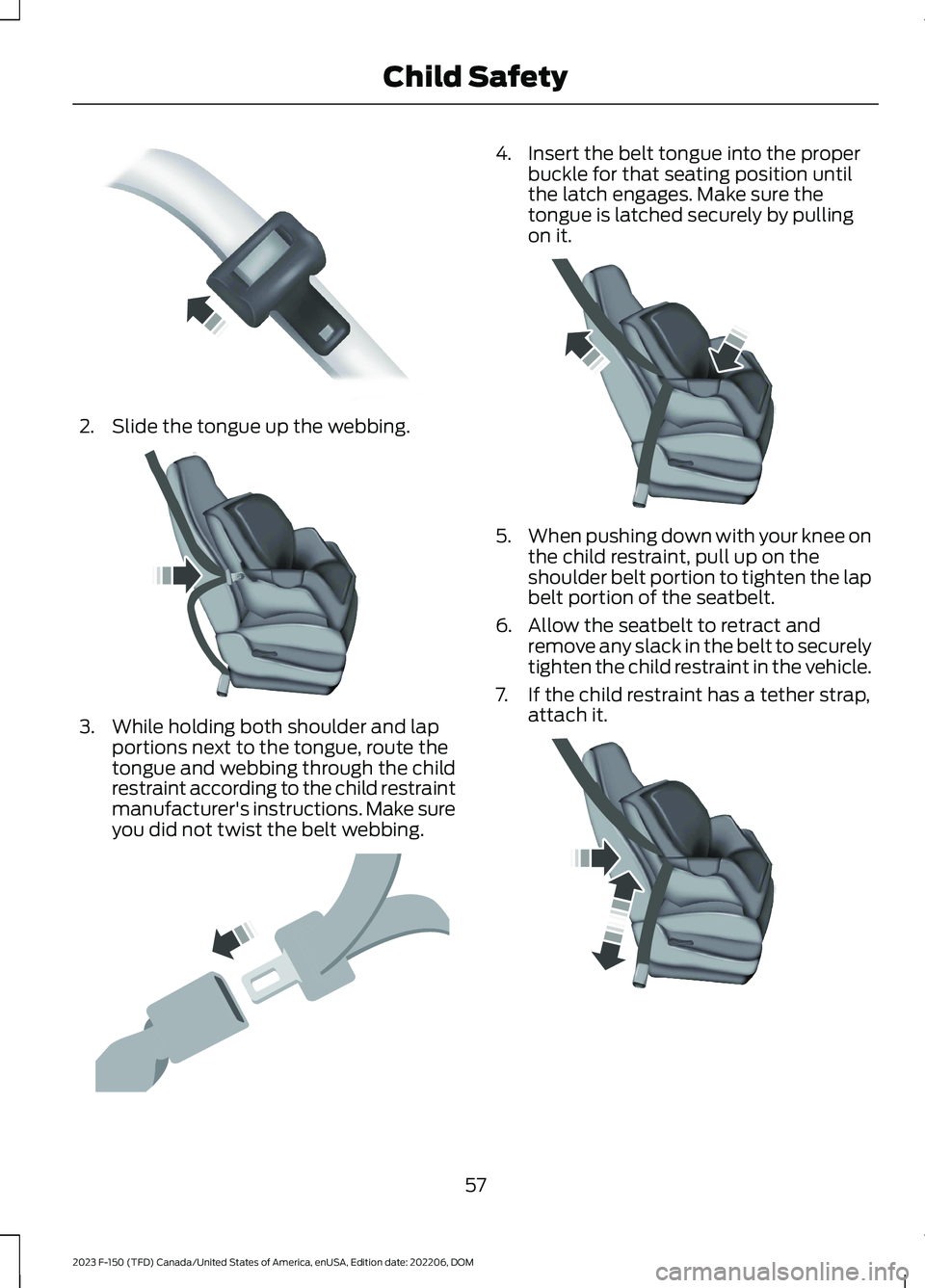
2.Slide the tongue up the webbing.
3.While holding both shoulder and lapportions next to the tongue, route thetongue and webbing through the childrestraint according to the child restraintmanufacturer's instructions. Make sureyou did not twist the belt webbing.
4.Insert the belt tongue into the properbuckle for that seating position untilthe latch engages. Make sure thetongue is latched securely by pullingon it.
5.When pushing down with your knee onthe child restraint, pull up on theshoulder belt portion to tighten the lapbelt portion of the seatbelt.
6.Allow the seatbelt to retract andremove any slack in the belt to securelytighten the child restraint in the vehicle.
7.If the child restraint has a tether strap,attach it.
57
2023 F-150 (TFD) Canada/United States of America, enUSA, Edition date: 202206, DOMChild SafetyE162708 E142530 E142531 E142533 E142534
Page 62 of 786
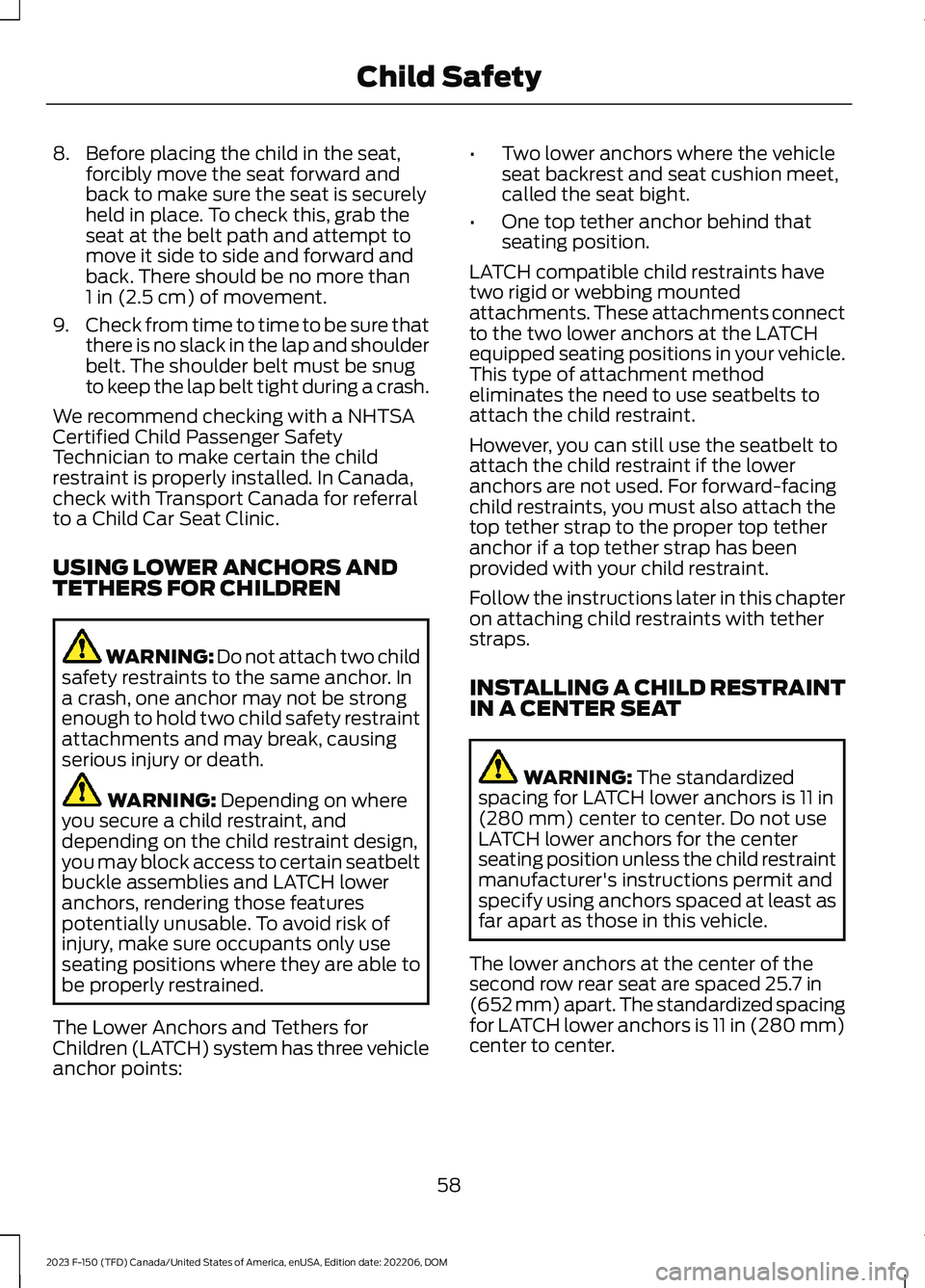
8.Before placing the child in the seat,forcibly move the seat forward andback to make sure the seat is securelyheld in place. To check this, grab theseat at the belt path and attempt tomove it side to side and forward andback. There should be no more than1 in (2.5 cm) of movement.
9.Check from time to time to be sure thatthere is no slack in the lap and shoulderbelt. The shoulder belt must be snugto keep the lap belt tight during a crash.
We recommend checking with a NHTSACertified Child Passenger SafetyTechnician to make certain the childrestraint is properly installed. In Canada,check with Transport Canada for referralto a Child Car Seat Clinic.
USING LOWER ANCHORS ANDTETHERS FOR CHILDREN
WARNING: Do not attach two childsafety restraints to the same anchor. Ina crash, one anchor may not be strongenough to hold two child safety restraintattachments and may break, causingserious injury or death.
WARNING: Depending on whereyou secure a child restraint, anddepending on the child restraint design,you may block access to certain seatbeltbuckle assemblies and LATCH loweranchors, rendering those featurespotentially unusable. To avoid risk ofinjury, make sure occupants only useseating positions where they are able tobe properly restrained.
The Lower Anchors and Tethers forChildren (LATCH) system has three vehicleanchor points:
•Two lower anchors where the vehicleseat backrest and seat cushion meet,called the seat bight.
•One top tether anchor behind thatseating position.
LATCH compatible child restraints havetwo rigid or webbing mountedattachments. These attachments connectto the two lower anchors at the LATCHequipped seating positions in your vehicle.This type of attachment methodeliminates the need to use seatbelts toattach the child restraint.
However, you can still use the seatbelt toattach the child restraint if the loweranchors are not used. For forward-facingchild restraints, you must also attach thetop tether strap to the proper top tetheranchor if a top tether strap has beenprovided with your child restraint.
Follow the instructions later in this chapteron attaching child restraints with tetherstraps.
INSTALLING A CHILD RESTRAINTIN A CENTER SEAT
WARNING: The standardizedspacing for LATCH lower anchors is 11 in(280 mm) center to center. Do not useLATCH lower anchors for the centerseating position unless the child restraintmanufacturer's instructions permit andspecify using anchors spaced at least asfar apart as those in this vehicle.
The lower anchors at the center of thesecond row rear seat are spaced 25.7 in(652 mm) apart. The standardized spacingfor LATCH lower anchors is 11 in (280 mm)center to center.
58
2023 F-150 (TFD) Canada/United States of America, enUSA, Edition date: 202206, DOMChild Safety
Page 63 of 786
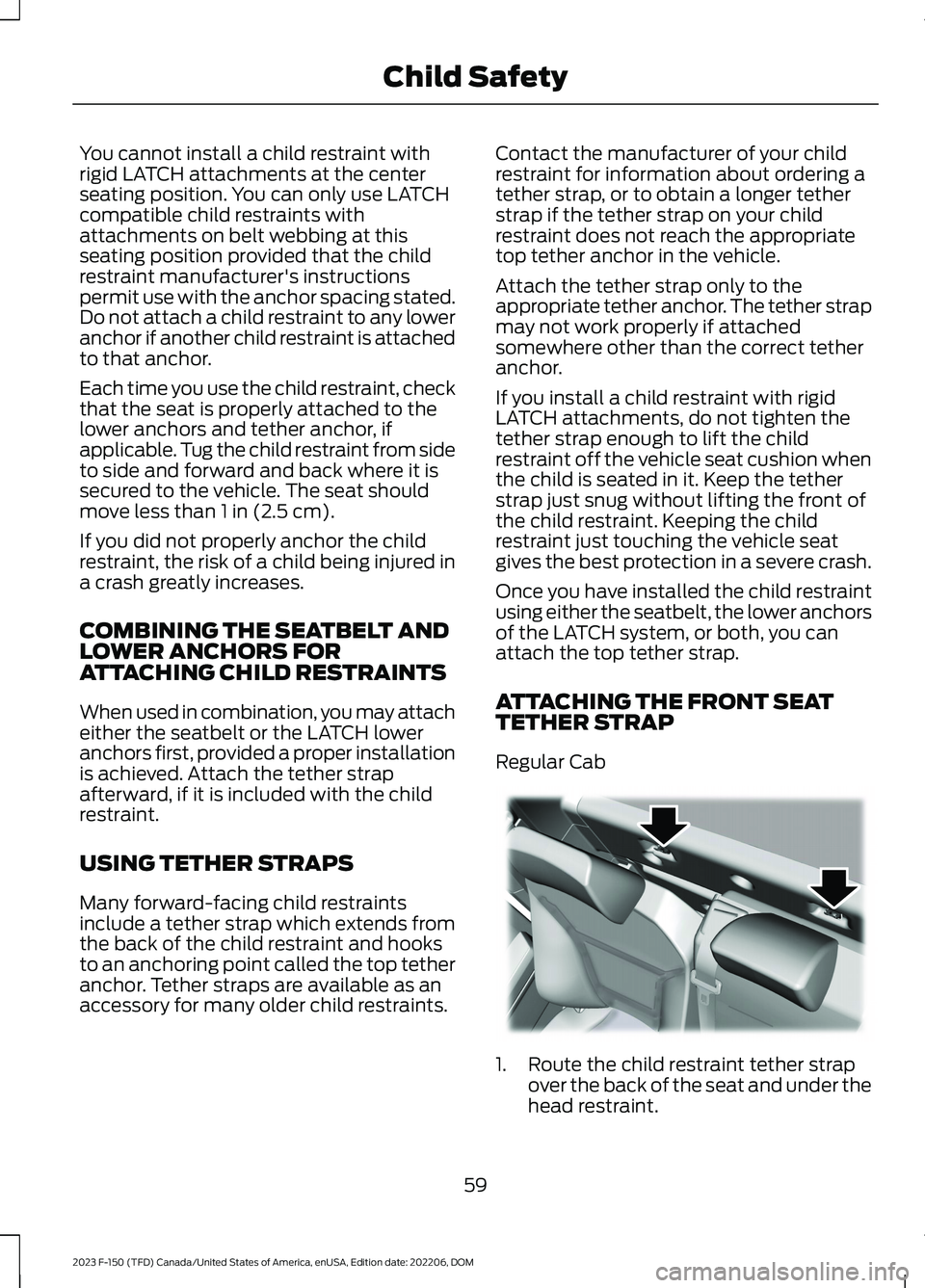
You cannot install a child restraint withrigid LATCH attachments at the centerseating position. You can only use LATCHcompatible child restraints withattachments on belt webbing at thisseating position provided that the childrestraint manufacturer's instructionspermit use with the anchor spacing stated.Do not attach a child restraint to any loweranchor if another child restraint is attachedto that anchor.
Each time you use the child restraint, checkthat the seat is properly attached to thelower anchors and tether anchor, ifapplicable. Tug the child restraint from sideto side and forward and back where it issecured to the vehicle. The seat shouldmove less than 1 in (2.5 cm).
If you did not properly anchor the childrestraint, the risk of a child being injured ina crash greatly increases.
COMBINING THE SEATBELT ANDLOWER ANCHORS FORATTACHING CHILD RESTRAINTS
When used in combination, you may attacheither the seatbelt or the LATCH loweranchors first, provided a proper installationis achieved. Attach the tether strapafterward, if it is included with the childrestraint.
USING TETHER STRAPS
Many forward-facing child restraintsinclude a tether strap which extends fromthe back of the child restraint and hooksto an anchoring point called the top tetheranchor. Tether straps are available as anaccessory for many older child restraints.
Contact the manufacturer of your childrestraint for information about ordering atether strap, or to obtain a longer tetherstrap if the tether strap on your childrestraint does not reach the appropriatetop tether anchor in the vehicle.
Attach the tether strap only to theappropriate tether anchor. The tether strapmay not work properly if attachedsomewhere other than the correct tetheranchor.
If you install a child restraint with rigidLATCH attachments, do not tighten thetether strap enough to lift the childrestraint off the vehicle seat cushion whenthe child is seated in it. Keep the tetherstrap just snug without lifting the front ofthe child restraint. Keeping the childrestraint just touching the vehicle seatgives the best protection in a severe crash.
Once you have installed the child restraintusing either the seatbelt, the lower anchorsof the LATCH system, or both, you canattach the top tether strap.
ATTACHING THE FRONT SEATTETHER STRAP
Regular Cab
1.Route the child restraint tether strapover the back of the seat and under thehead restraint.
59
2023 F-150 (TFD) Canada/United States of America, enUSA, Edition date: 202206, DOMChild SafetyE175295
Page 64 of 786
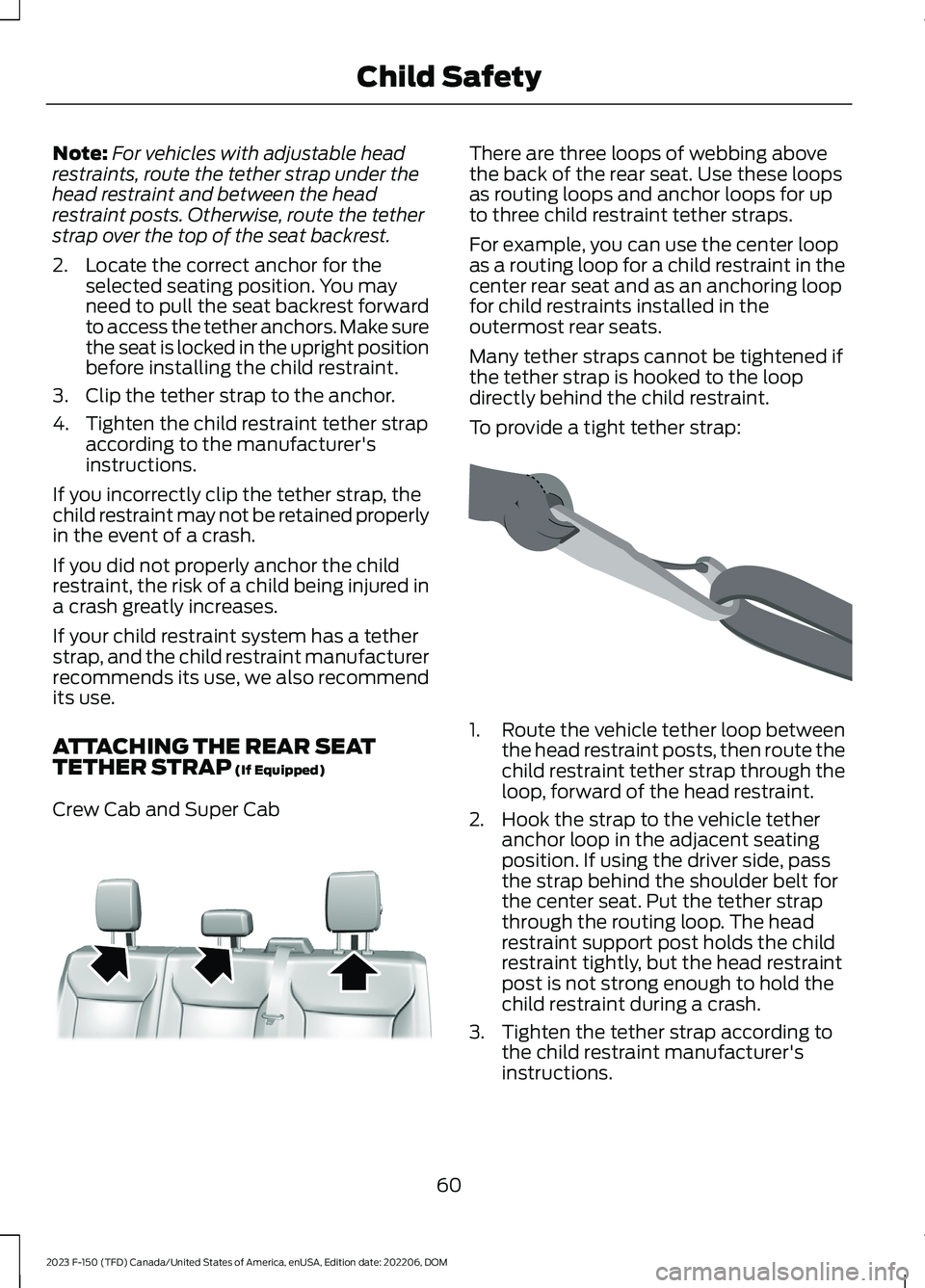
Note:For vehicles with adjustable headrestraints, route the tether strap under thehead restraint and between the headrestraint posts. Otherwise, route the tetherstrap over the top of the seat backrest.
2.Locate the correct anchor for theselected seating position. You mayneed to pull the seat backrest forwardto access the tether anchors. Make surethe seat is locked in the upright positionbefore installing the child restraint.
3.Clip the tether strap to the anchor.
4.Tighten the child restraint tether strapaccording to the manufacturer'sinstructions.
If you incorrectly clip the tether strap, thechild restraint may not be retained properlyin the event of a crash.
If you did not properly anchor the childrestraint, the risk of a child being injured ina crash greatly increases.
If your child restraint system has a tetherstrap, and the child restraint manufacturerrecommends its use, we also recommendits use.
ATTACHING THE REAR SEATTETHER STRAP (If Equipped)
Crew Cab and Super Cab
There are three loops of webbing abovethe back of the rear seat. Use these loopsas routing loops and anchor loops for upto three child restraint tether straps.
For example, you can use the center loopas a routing loop for a child restraint in thecenter rear seat and as an anchoring loopfor child restraints installed in theoutermost rear seats.
Many tether straps cannot be tightened ifthe tether strap is hooked to the loopdirectly behind the child restraint.
To provide a tight tether strap:
1.Route the vehicle tether loop betweenthe head restraint posts, then route thechild restraint tether strap through theloop, forward of the head restraint.
2.Hook the strap to the vehicle tetheranchor loop in the adjacent seatingposition. If using the driver side, passthe strap behind the shoulder belt forthe center seat. Put the tether strapthrough the routing loop. The headrestraint support post holds the childrestraint tightly, but the head restraintpost is not strong enough to hold thechild restraint during a crash.
3.Tighten the tether strap according tothe child restraint manufacturer'sinstructions.
60
2023 F-150 (TFD) Canada/United States of America, enUSA, Edition date: 202206, DOMChild SafetyE309318 E309384
Page 65 of 786
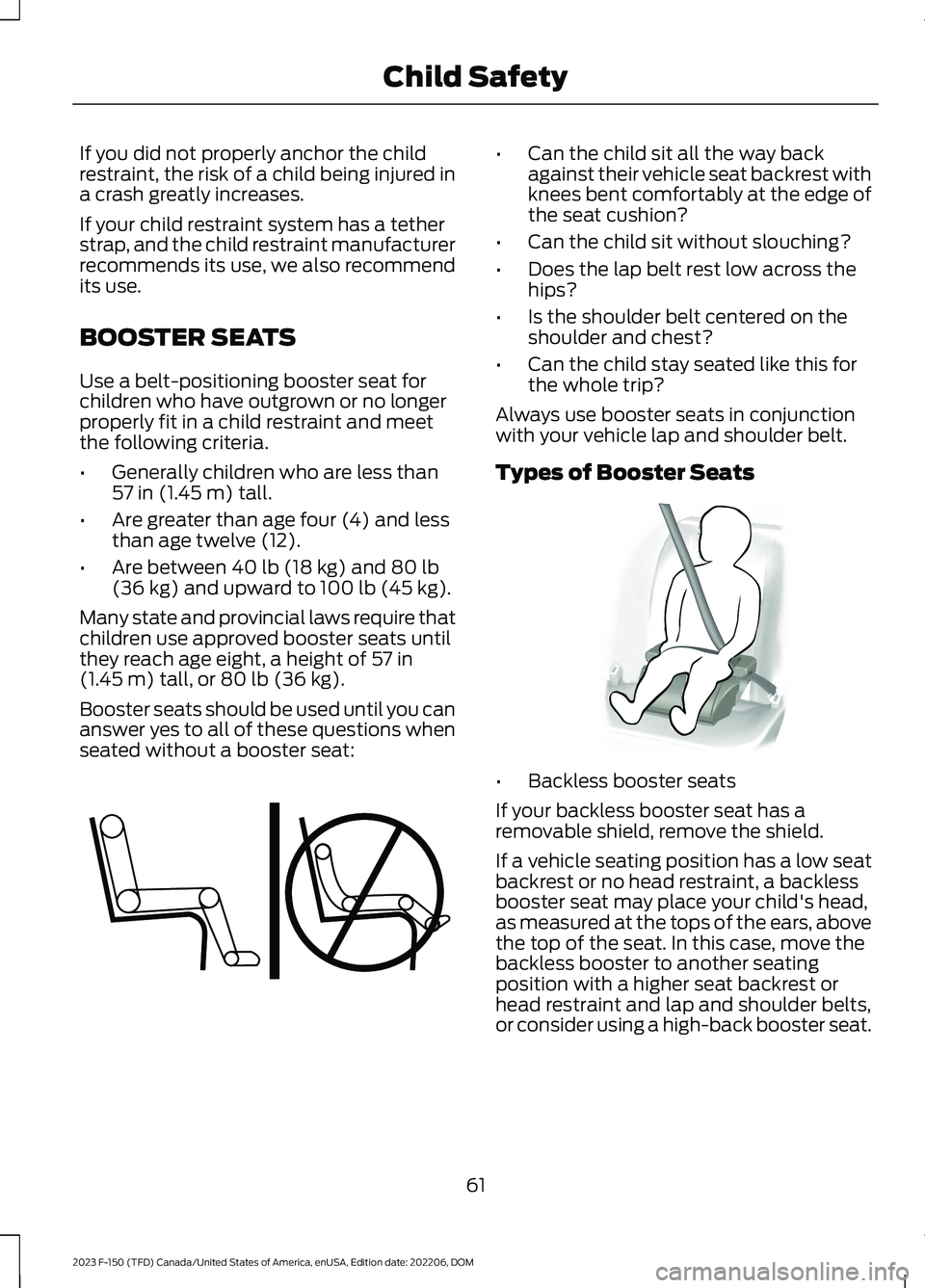
If you did not properly anchor the childrestraint, the risk of a child being injured ina crash greatly increases.
If your child restraint system has a tetherstrap, and the child restraint manufacturerrecommends its use, we also recommendits use.
BOOSTER SEATS
Use a belt-positioning booster seat forchildren who have outgrown or no longerproperly fit in a child restraint and meetthe following criteria.
•Generally children who are less than57 in (1.45 m) tall.
•Are greater than age four (4) and lessthan age twelve (12).
•Are between 40 lb (18 kg) and 80 lb(36 kg) and upward to 100 lb (45 kg).
Many state and provincial laws require thatchildren use approved booster seats untilthey reach age eight, a height of 57 in(1.45 m) tall, or 80 lb (36 kg).
Booster seats should be used until you cananswer yes to all of these questions whenseated without a booster seat:
•Can the child sit all the way backagainst their vehicle seat backrest withknees bent comfortably at the edge ofthe seat cushion?
•Can the child sit without slouching?
•Does the lap belt rest low across thehips?
•Is the shoulder belt centered on theshoulder and chest?
•Can the child stay seated like this forthe whole trip?
Always use booster seats in conjunctionwith your vehicle lap and shoulder belt.
Types of Booster Seats
•Backless booster seats
If your backless booster seat has aremovable shield, remove the shield.
If a vehicle seating position has a low seatbackrest or no head restraint, a backlessbooster seat may place your child's head,as measured at the tops of the ears, abovethe top of the seat. In this case, move thebackless booster to another seatingposition with a higher seat backrest orhead restraint and lap and shoulder belts,or consider using a high-back booster seat.
61
2023 F-150 (TFD) Canada/United States of America, enUSA, Edition date: 202206, DOMChild SafetyE142595 E68924
Page 66 of 786
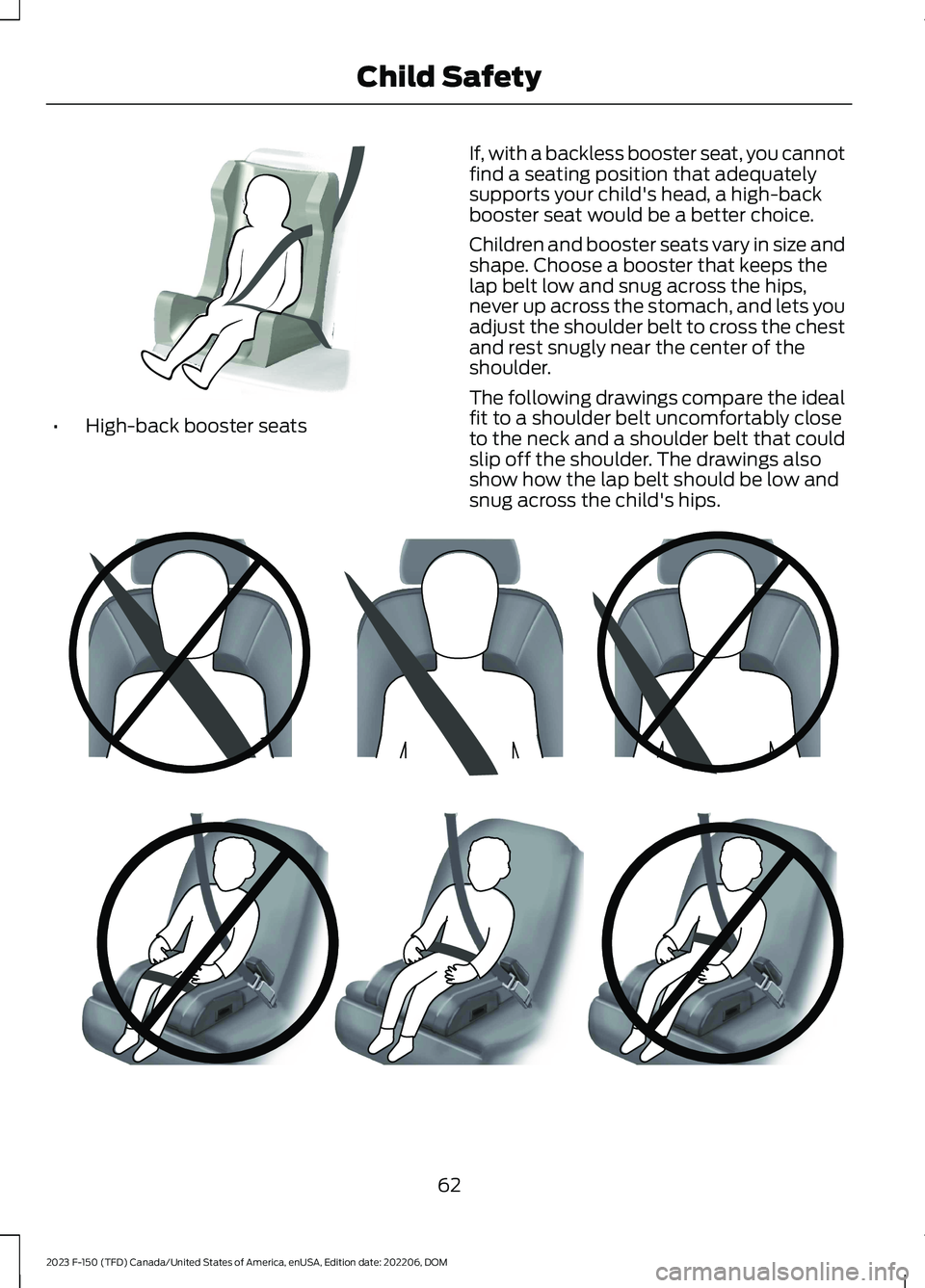
•High-back booster seats
If, with a backless booster seat, you cannotfind a seating position that adequatelysupports your child's head, a high-backbooster seat would be a better choice.
Children and booster seats vary in size andshape. Choose a booster that keeps thelap belt low and snug across the hips,never up across the stomach, and lets youadjust the shoulder belt to cross the chestand rest snugly near the center of theshoulder.
The following drawings compare the idealfit to a shoulder belt uncomfortably closeto the neck and a shoulder belt that couldslip off the shoulder. The drawings alsoshow how the lap belt should be low andsnug across the child's hips.
62
2023 F-150 (TFD) Canada/United States of America, enUSA, Edition date: 202206, DOMChild SafetyE70710 E142596 E142597